1960-1969
1968 Cadillac Eldorado
- Details
- Written by Big Block
- Category: 1960-1969
- Hits: 5001
1968 Cadillac Eldorado
| FLEETWOOD ELDORADO SUB-SERIES 693 |
In a way, you can call the 1968-70 Eldorado a modern classic and certainly a collectible. For 1968 came a new 472-cid V-8 with 35 more horses than the 429-cid engine it replaced and 45 more torque to reach a thumping 525 lbs/ft torque. It was designed mainly for easier emissions control in that first year of federal smog standards. Now it was possible to spin the front-driven wheels on smooth, dry surfaces. Cadillac proudly noted that most engine accessories bolted rigidly to the block, rather than being attached by brackets, and boasted about the new V-8's two-million miles of testing. 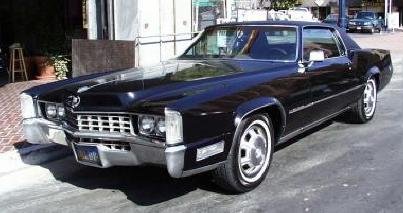
Washington also decreed new safety features for 1968. Eldorado complied with discreet round side-marker lights, thicker dash padding, and non-injury interior hardware. Left alone were the broad hidden headlamp eggcrate grille distinctive vee'd backlight (i.e., back window), knife-edge fenderlines, and small backward-sliding rear-quarter windows. Wipers, however, were newly concealed by extending the hood 4.5 inches toward the cowl. The Eldorado had the front parking lamps located on the leading edge of the fenders where they were mounted vertically. The design of the lens for the front cornering lamps (formerly vertically ribbed) was modified. 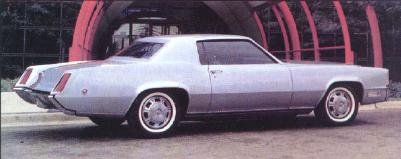 Spring rates were slightly lowered to give a cushier ride. Upholstery trims included diamond pattern cloth and vinyl; DeVille cloth with vinyl bolsters in four color choices and genuine leather options. Removed from the rear roof pillar, but not the hood and deck lid, were the familiar wreath and crest style Fleetwood emblems. Regular equipment on the luxury sports type car included all Fleetwood standards plus power rear quarter ventipanes; power front disc brakes; retractable headlamp covers; and Rosewood pattern dash panel appliqués.
Spring rates were slightly lowered to give a cushier ride. Upholstery trims included diamond pattern cloth and vinyl; DeVille cloth with vinyl bolsters in four color choices and genuine leather options. Removed from the rear roof pillar, but not the hood and deck lid, were the familiar wreath and crest style Fleetwood emblems. Regular equipment on the luxury sports type car included all Fleetwood standards plus power rear quarter ventipanes; power front disc brakes; retractable headlamp covers; and Rosewood pattern dash panel appliqués.
Though base price jumped some $330, due mainly to the new safety and emissions gear, Eldorado production improved by nearly 37 percent for the model year, reaching over 24,000 units.

| Model number | Body/Style number | Body type | Seating | Factory price | Shipping weight | Production |
| 68-693 | 69347H | 2-dr hardtop Coupe
| 6 pass. | $6605 | 4580 lb | 24,528 |
ELDORADO ENGINE | |
| Engine type | V-8 Overhead valves. Cast iron block |
| Displacement | 472 cubic inches |
| Bore & stroke | 4.30 x 4.06 inches |
| Compression ratio | 10.5:1 |
| Brake horsepower (SAE gross) | 375 @ 4400 rpm |
| Torque | 525 @ 3000 rpm |
| Main bearings | five |
| Valve lifters | Hydraulic |
| Carburetor | Rochester four-barrel Quadrajet model 4MV (Eldorado type) |
| Transmission | Turbo-Hydramatic |
| Standard axle ratio | 3.07:1 |
CHASSIS DIMENSIONS | |
| Wheelbase | 120 inches |
| Overall length | 221.5 inches |
AVAILABLE OPTIONS | |
Auxillary horn | $16 |
Automatic Climate Control | $516 |
Bucket seats with console (with leather upholstery required) | $184 |
Firemist paint | $132 |
Cruise control | $95 |
Rear window defogger | $26 |
Front disc brakes | $105 |
Door-edge guards | $5 |
One-piece front and rear floor mat | $20 |
Soft Ray glass | $51 |
Guide-Matic headlamp control | $51 |
Head restraints | $53 |
Leather upholstery | $158 |
License frame(s) | $6-13 |
Power door locks | $47 |
Rear quarter power ventipanes | $63 |
AM radio | $162 |
AM/FM stereo radio | $288 |
AM/FM radio | $188 |
Reclining front seat with headrests | $84 |
Power seats with lefthand Four-Way bucket | $53 |
Power seats with Six-Way front | $83 |
Rear center seat belt | $11 |
Front seat warmer | $95 |
Shoulder belts | $32 |
Tilt & telescope steering wheel | $90 |
Remote control trunk lock | $52 |
Twilight Sentinel | $37 |
Padded vinyl roof | $132 |

| HISTORICAL |
- Dealer introduction for 1968 Cadillac’s and Eldorado’s took place September 21, 1967.
- Fourth successive yearly sales record set this year despite 21 day UAW shutdown at Fisher Body Fleetwood plant in Detroit (November 1967)
- Production was down 1.1 percent, due to same strike.
- Four-wheel disc brakes with floating calipers optionally available.
- All-new dash-board design.
- Larger, shrouded rear view mirrors to eliminate wind buffeting.
1968 Cadillac DeVille
- Details
- Written by Big Block
- Category: 1960-1969
- Hits: 2790
1968 Cadillac DeVille
| DEVILLE (V-8) - SERIES 683 |
On paper, it seemed that the main distinctions of cars in the DeVille lineup were the installation of a power-operated front seat with horizontal adjustment and the addition of illuminated door panel reflectors. There were, however, richer appointments inside and out, including the traditional rear fender Tiffany-like scripts and plusher upholstery trims. In addition, twice as many body styles were provided in DeVille level finish.
| CADILLAC ENGINE |
- V-8. Overhead valves.
- Cast iron block.
- Displacement: 472 cubic inches.
- Bore and stroke: 4.30 x 4.06 inches.
- Compression ratio: 10.5:1.
- Brake horsepower: 375 at 4400 rpm
- Five main bearings.
- Hydraulic valve lifters.
- Carburetor: Rochester Quadrajet four-barrel model 7028210S.
- a metal temperature monitoring device
- air injection emissions control system
- integral air-conditioning system (still optional)
- cast crankshaft and connecting rods
- integral water crossover pipe with thermostatic passages
- engine bearings with more surface area
- 15-plate battery.
| Model Number | Style Number | Body Type | Seating | Factory Price | Shipping Weight | Production Total |
| 68-683 | 68369-L | 4-door Sedan  | 6 | 5785 | 4680 | 9,850 |
| 68-683 | 68349-B | 4-door Hardtop Sedan  | 6 | 5785 | 4675 | 72,662 |
| 68-683 | 68347-J | 2-door Coupe DeVille  | 6 | 5552 | 4595 | 63,935 |
| 68-683 | 68367-F | 2-door Convertible Deville  | 6 | 5736 | 4600 | 18,025 |
NOTE: Some sources list lower prices for 1968 Cadillac’s, indicating a mid-year availability and prices of options and accessories were increase. The higher recorded prices are being used here.
| CHASSIS |
- Wheelbase: 129.5"
- Overall length: 224.7"
- Rear axle ratio: 2.94:1
- Transmission: three-speed Turbo-Hydramatic
- Tires: 9.00 x 15
- Front tread: not available
- rear Tread: not available
| POWER TRAIN OPTIONS |
- Optional axle ratio data not available.
- Air injector reactor and closed positive crankcase ventilation standard.
- Controlled differential was now $52.65 extra on all models except Eldorado.
| CONVENIENCE OPTIONS |
Availability and prices of options and accessories were largely the same as 1967
- Auxiliary horn ($16)
- Automatic level control option on models Calais or Deville ($79)
- Automatic Climate Control ($516)
- Bucket seats with console on models Deville (F-J-B) with leather upholstery required ($184)
- Firemist finish ($132)
- Cruise control ($95)
- Rear window defogger on models Calais, Deville (J-B-L) ($27)
- Door guards ($5-8)
- Expanded vinyl upholstery on models Calais ($42)
- Soft Ray glass ($51)
- Guide-Matic headlamp control ($51)
- Head rests ($53)
- Leather upholstery, models J-B-L ($138)
- License frame ($13 pair)
- Padded roof, models J ($132); models B-L ($137)
- Power door locks, two-door ($47); four-door ($68)
- Power ventipanes with required power windows ($72)
- Power windows on Calais models ($116)
- AM radio ($162)
- AM/FM radio ($188)
- AM/FM stereo ($288)
- Reclining front seat with headrests on Convertible with required bucket seats ($84)
- Four-way lefthand power bucket seat on models F-J-B ($53)
- Six-way power front seat on models G-N-K ($111); models F-J-B-L ($83)
- Rear center seat belt ($11)
- Front shoulder straps ($32)
- Tilt-telescope steering wheel ($90)
- Remote control trunk lock ($52)
- Twilight Sentinel ($32)
- White sidewall tires, size 9.00 x 15 four-ply 8PR-5 ($56 exchange)
- New items of optional equipment were added as well:
- Twin front and rear floor mats for all Calais & DeVille ($17)
- Front seat warmer for all Calais & DeVille ($95)
1968 Cadillac Calais
- Details
- Written by Big Block
- Category: 1960-1969
- Hits: 1976
1968 Cadillac Calais

| CALAIS SERIES 682 |
Cadillac was not about to alter its popular product in any major way, so the same basic styling and engineering continued into the 1968 model year with a number of refinements, but no drastic changes. New grilles were added. They had an insert with a finer mesh and step-down outer section which held the rectangular parking lights just a little higher than before. Rear end styling was very modestly altered. An obvious change was a 6-1/2 inch longer hood, designed to accomodate recessed windshield wiper’s, The deck lid also had more of a rake. An enlarged engine offered more cubic inches and torque than any other American V-8 and put out 375 horsepower. Of 20 exterior paint color combinations, 14 were totally new. On the inside, enriched appointments included molded inner door panels and a selection of 147 upholstery combinations, 76 in cloth, 67 in leather and four in vinyl. The Calais four-door pillared sedan was dropped. Standard features for the two remaining styles included:
- Turbo-Hydramatic
- power steering
- power brakes
- power windows
- heater and defroster
- center arm rests
- electric clock
- dual backup lamps
- cornering lights
- front and rear side marker lamps
- Light Group
- Mirror Group
- padded instrument panel
- seat belts
- trip odometer
- ignition key warning buzzer
- recessed three-speed wipers and washers
- five 9.00 x 15 blackwall tires
| Model Number | Style Number | Body Type | Seating | Factory Price | Shipping Weight | Production Total |
| 68-682 | 68247-G | 2-door Coupe  | 6 | 5315 | 4570 | 8,165 |
| 68-682 | 68249-N | 4-door Hardtop Sedan  | 6 | 5491 | 4640 | 10,025 |
| CADILLAC ENGINE |
- V-8. Overhead valves.
- Cast iron block.
- Displacement: 472 cubic inches.
- Bore and stroke: 4.30 x 4.06 inches.
- Compression ratio: 10.5:1.
- Brake horsepower: 375 at 4400 rpm
- Five main bearings.
- Hydraulic valve lifters.
- Carburetor: Rochester Quadrajet four-barrel model 7028210S.
- a metal temperature monitoring device
- air injection emissions control system
- integral air-conditioning system (still optional)
- cast crankshaft and connecting rods
- integral water crossover pipe with thermostatic passages
- engine bearings with more surface area
- 15-plate battery.
| CHASSIS |
- Wheelbase: 129.5"
- Overall length: 224.7"
- Rear axle ratio: 2.94:1
- Transmission: three-speed Turbo-Hydramatic
- Tires: 9.00 x 15
- Front tread: not available
- Rear tread: not available
| POWER TRAIN OPTIONS |
- Optional axle ratio data not available.
- Air injector reactor and closed positive crankcase ventilation standard.
- Controlled differential was now $52.65 extra on all models except Eldorado.
| CONVENIENCE OPTIONS |
Availability and prices of options and accessories were largely the same as 1967
- Auxiliary horn ($16)
- Automatic level control option on models Calais or Deville ($79)
- Automatic Climate Control ($516)
- Bucket seats with console on models Deville (F-J-B) with leather upholstery required ($184)
- Firemist finish ($132)
- Cruise control ($95)
- Rear window defogger on models Calais, Deville (J-B-L) ($27)
- Door guards ($5-8)
- Expanded vinyl upholstery on models Calais ($42)
- Soft Ray glass ($51)
- Guide-Matic headlamp control ($51)
- Head rests ($53)
- Leather upholstery, models J-B-L ($138)
- License frame ($13 pair)
- Padded roof, models J ($132); models B-L ($137)
- Power door locks, two-door ($47); four-door ($68)
- Power ventipanes with required power windows ($72)
- Power windows on Calais models ($116)
- AM radio ($162)
- AM/FM radio ($188)
- AM/FM stereo ($288)
- Reclining front seat with headrests on Convertible with required bucket seats ($84)
- Four-way left hand power bucket seat on models F-J-B ($53)
- Six-way power front seat on models G-N-K ($111); models F-J-B-L ($83)
- Rear center seat belt ($11)
- Front shoulder straps ($32)
- Tilt-telescope steering wheel ($90)
- Remote control trunk lock ($52)
- Twilight Sentinel ($32)
- White sidewall tires, size 9.00 x 15 four-ply 8PR-5 ($56 exchange)
- New items of optional equipment were added as well:
- Twin front and rear floor mats for all Calais & DeVille ($17)
- Front seat warmer for all Calais & DeVille ($95).
1968 Cadillac Overview
- Details
- Written by Big Block
- Category: 1960-1969
- Hits: 3455
1968 Cadillac Overview
 The 1968 spotlight was on motive power: an all-new 472-cid V-8 with 375 bhp. Designed to meet the new government emission standards that took effect that year, it was extensively tested in the laboratory, being run the equivalent of 500,000 miles. Though not as fuel-efficient as its predecessor, the 472 could boast of being the largest production engine offered in the industry. Designwise, the '68 Eldorado gained the federally required side marker lights, plus larger taillights, combined turn signal/parking lamps nested in the front-fender caps, and a hood extended at the rear to conceal the windshield wipers. Standards also got the hidden wipers and side markers, along with a revised grille.
The 1968 spotlight was on motive power: an all-new 472-cid V-8 with 375 bhp. Designed to meet the new government emission standards that took effect that year, it was extensively tested in the laboratory, being run the equivalent of 500,000 miles. Though not as fuel-efficient as its predecessor, the 472 could boast of being the largest production engine offered in the industry. Designwise, the '68 Eldorado gained the federally required side marker lights, plus larger taillights, combined turn signal/parking lamps nested in the front-fender caps, and a hood extended at the rear to conceal the windshield wipers. Standards also got the hidden wipers and side markers, along with a revised grille.
| CADILLAC I. D. NUMBERS |
- Vehicle identification numbers were stamped on the top of the instrument panel this year and were visible through the windshield.
- The first symbol was a "6" for Cadillac.
- The second and third symbols correspond to the same symbols in the series code number.
- The fourth and fifth symbols correspond to the last two symbols in the standard Fisher Body Division code (Style Number without letter suffix)
- The Sixth symbol was an "8" for 1968 model year.
- The seventh symbol was an assembly plant code as follows:
- "Q" - Detroit, Michigan
- "E" - Linden, New Jersey
- The next group of six numbers was the sequential unit production code.
- The number sequence began with 100001 at each assembly plant.
- Body Style Numbers, on the vehicle data plate (located on firewall) were prefixed with "68" for 1968 and suffixed with a single letter, which also indicated series and model and corresponds to the letter on the charts below.
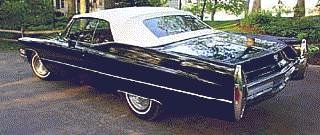
| HISTORICAL |
- Dealer introduction for 1968 Cadillac’s and Eldorado’s took place September 21, 1967.
- Fourth successive yearly sales record set this year despite 21 day UAW shutdown at Fisher Body Fleetwood plant in Detroit (November 1967)
- Production was down 1.1 percent, due to same strike.
- Four-wheel disc brakes with floating calipers optionally available.
- All-new dash-board design.
- Larger, shrouded rear view mirrors to eliminate wind buffeting.
1967 Cadillac Fleetwood
- Details
- Written by Big Block
- Category: 1960-1969
- Hits: 2578
1967 Cadillac Fleetwood
| FLEETWOOD SIXTY-SPECIAL SUB-SERIES 680/681 |
Full-length bright metal body underscores; Fleetwood wreath and crest emblems for the hood, trunk and roof pillar; the lack of horizontal lower body rub moldings and Fleetwood block letters on the lower front fenders and passenger side of the deck lid characterized the new Sixty-Specials. The Brougham featured a padded Cordova vinyl top with model identification scripts attached to the roof "C" pillar. Added to the list of DeVille equipment were Automatic Level Control suspension and power operated ventipanes. The Brougham also included lighted fold-down trays; adjustable reading lamps and carpeted fold-down footrests.
| Model Number | Style Number | Body Type | Seating | Factory Price | Shipping Weight | Production Total |
| 67-680 | 68069-M | 4-door Sedan
| 6 | 6423 | 4685 | 3,550 |
| 67-681 | 68169-P | 4-door Brougham
| 6 | 6739 | 4735 | 12,750 |
| FLEETWOOD SEVENTY-FIVE SUB-SERIES 697/698 |
The year's new styling was beautifully rendered on the Cadillac long-wheelbase models which had extra-long rear fenders and an extended "greenhouse" with a formal, high-headroom look. Fleetwood wreath and crest emblems decorated the hood and the trunk and there were Fleetwood block letters at the right side of the deck lid. A simple horizontal body rub molding, lengthened to fit the elongated sheet metal, trimmed the sides of these elegant machines. Standard equipment included all found in DeVilles plus Automatic Level Control; air-conditioning; carpeted fold-down foot rests and 8.20 x 15, four-ply 8PR black tires.
| Model Number | Style Number | Body Type | Seating | Factory Price | Shipping Weight | Production Total |
| 67-697 | 69723-R | 4-door Sedan
| 6 | 10,360 | 5335 | 835 |
| 67-697 | 69733-S | 4-door Limousine
| 6 | 10,571 | 5450 | 965 |
| 67-698 | 69890-Z | Commercial chassis | - | - | - | 2333 |
NOTE: The commercial chassis was built on a 156 inch wheelbase and was provided to professional car builders for the manufacture of hearses and ambulances, etc.
| ENGINE |
- V-8 Overhead valves
- Cast iron block
- Displacement: 429 cubic inches
- Bore and stroke: 4.13 x 4.00 inches
- Compression ratio: 10.5:1
- Brake horsepower: 340 @ 4600 rpm
- Five main bearings
- Hydraulic valve lifters
- Carburetor: Rochester four-barrel type, model 7026030
| CHASSIS |
| Feature | Series 75 | Series 60 | Commercial chassis |
| Wheelbase | 149.8" | 133" | 156" |
| Overall length | 244.5" | 227.5" | - |
| Rear axle ratio | 2.94:1 | ||
| Transmission | three-speed Turbo-Hydramatic | ||
| Tires | 8.20 x 15 | 9.00 x 15 | |
| Front tread | not available | ||
| Rear Tread | not available | ||
| POWER TRAIN OPTIONS |
- A 3.21:1 rear axle gear ratio was standard on Series Seventy-Five and Eldorado; optional on other models.
- A controlled differential was $40.15 extra on all models except Eldorado’s.
- An air injection reactor was $34.13 extra on all Cadillac’s and required on all cars built for California sale.
- Closed positive crankcase ventilators were $4 extra on all Cadillac’s and required on all cars built for California sale.
| CONVENIENCE OPTIONS |
- Auxiliary horn ($12)
- Automatic Climate Control on Sixty-Special models ($516)
- Firemist finish ($132)
- Cruise control ($95)
- Rear window defogger on models Sixty-Special ($27)
- Door guards ($8)
- Soft Ray glass ($51)
- Guide-Matic headlamp control ($50)
- Head rests ($53)
- Leather upholstery on Sixty-Special ($138)
- License frame, single ($6), pair ($12)
- Power door locks ($68)
- Power door locks for Fleetwood 75 models ($116)
- AM radio ($162)
- AM/FM radio ($188)
- AM/FM stereo on Sixty-Special ($288)
- AM radio rear controls on Fleetwood 75 models ($242)
- Six-way power front seat on models M-P-R ($83)
- Rear center seat belt ($11)
- Front shoulder straps ($32)
- Tilt-telescope steering wheel ($90)
- Remote control trunk lock ($52)
- Twilight Sentinel ($32)
- White sidewall tires, size 9.00 x 15 four-ply 8PR-5, except nine-passenger models ($56 exchange)
- White sidewall tires, size 8.20 x 15, four-ply 8PR-5 on nine-passenger models ($64 exchange).
| HISTORICAL |
- Dealer introduction date for 1967 Cadillac’s and Eldorado’s was October 6, 1966.
- The Eldorado featured concealed, horizontally mounted headlamps.
- A new assembly line was setup at the Detroit factory to build Eldorad‘b
- A third successive year of record production and sales was marked by Cadillac Division in 1967.
- Based on the Eldorado's popularity, Cadillac sales for a single month passed the 20,000 unit level for the first time in the company's history, setting an all-time high of 22,072 cars in October, 1966.
- A year later, 23,408 cars conforming to 1968 specifications were built in October, 1967.
- Calvin J. Werner was general manager of Cadillac; Fred T. Hopkins general sales manager; C.A. Rasmussen chief engineer and W.J. Knight public relations director.
1967 Cadillac Eldorado
- Details
- Written by Big Block
- Category: 1960-1969
- Hits: 2468
1967 Cadillac Eldorado
As it happened, Cadillac began experimenting with front drive during the Brougham years. But though a running chassis tested in late 1959 looked promising, fwd was still a relative novelty and by no means proven. Thus, when General Motors stylists began sketching a "new Brougham" that October, they devised shapes adaptable to either front or rear drive.
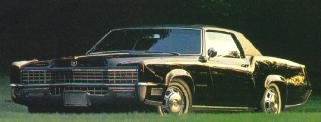 They worked on this experimental project, coded XP-727, through early 1962, when GM management approved front drive for a new "personal" Cadillac. The clincher was the successful engineering effort toward what would be GM's first production front-driver, the 1966 Oldsmobile Toronado. Engineering for both models was more or less combined by summer 1963, in project XP-784, but Eldorado styling originated in two separate programs: XP-820, begun in September, and the evolutionary XP-825, begun in December. The latter was production -- approved in May 1964, with shorter overhangs the major subsequent change. Unlike previous Eldorados, only a coupe was planned, with no evident thought of a convertible.
They worked on this experimental project, coded XP-727, through early 1962, when GM management approved front drive for a new "personal" Cadillac. The clincher was the successful engineering effort toward what would be GM's first production front-driver, the 1966 Oldsmobile Toronado. Engineering for both models was more or less combined by summer 1963, in project XP-784, but Eldorado styling originated in two separate programs: XP-820, begun in September, and the evolutionary XP-825, begun in December. The latter was production -- approved in May 1964, with shorter overhangs the major subsequent change. Unlike previous Eldorados, only a coupe was planned, with no evident thought of a convertible. 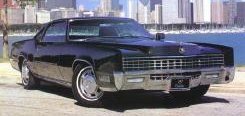 The new-generation Eldorado naturally inherited the Toronado's novel "split" driveline. This comprised a three-speed Turbo Hydra-Matic transmission mounted longitudinally beside the engine and driven from the flywheel by a Morse "Hy-Vo" inverted-tooth chain. Basic suspension was also shared: front A-arms, longitudinal torsion bars, and anti-roll bar; at the rear, a drop-center beam axle on single-leaf springs and four shock absorbers, two vertical, two horizontal.
The new-generation Eldorado naturally inherited the Toronado's novel "split" driveline. This comprised a three-speed Turbo Hydra-Matic transmission mounted longitudinally beside the engine and driven from the flywheel by a Morse "Hy-Vo" inverted-tooth chain. Basic suspension was also shared: front A-arms, longitudinal torsion bars, and anti-roll bar; at the rear, a drop-center beam axle on single-leaf springs and four shock absorbers, two vertical, two horizontal. 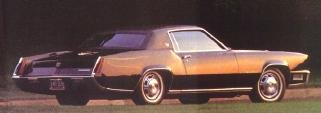 Beyond this were major differences. There was styling, of course: distinctly Cadillac, beautifully masterminded by GM design chief William L. Mitchell -- and so different from both the Toro and the second-generation 1966 Buick Riviera that some observers wondered whether they all really used the same new GM E-body. An Eldorado could have only Cadillac power, so the division's 429 V-8, new for '64, was modified for front drive with a new oil pan, exhaust manifolds, accessory drive, and engine mounts. Output was the same as for other '67 Cadillacs: 340 horsepower and 480 pounds/feet torque with four-barrel carburetor and a 10.5:1 compression ratio. Steering was GM's usual recirculating-ball mechanism, with variable-ratio power assistance. Standard front brakes were drums, but the optional power assisted four-piston radially vented front discs were a low-cost option ($105). At the back were duo-servo 11-inch diameter drums. (The Toro started with drums, then switched to front discs for '67.)
Beyond this were major differences. There was styling, of course: distinctly Cadillac, beautifully masterminded by GM design chief William L. Mitchell -- and so different from both the Toro and the second-generation 1966 Buick Riviera that some observers wondered whether they all really used the same new GM E-body. An Eldorado could have only Cadillac power, so the division's 429 V-8, new for '64, was modified for front drive with a new oil pan, exhaust manifolds, accessory drive, and engine mounts. Output was the same as for other '67 Cadillacs: 340 horsepower and 480 pounds/feet torque with four-barrel carburetor and a 10.5:1 compression ratio. Steering was GM's usual recirculating-ball mechanism, with variable-ratio power assistance. Standard front brakes were drums, but the optional power assisted four-piston radially vented front discs were a low-cost option ($105). At the back were duo-servo 11-inch diameter drums. (The Toro started with drums, then switched to front discs for '67.) 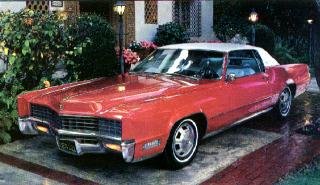 The Eldorado also differed in its inch-longer wheelbase -- 120 in all -- and unique suspension tuning. The latter included standard rear leveling and narrower, softer-riding tires, though the Cadillac handled at least as well as the Olds. Indeed, the '67 Eldorado was the closest thing to a "driver's Cadillac" in years. Motor Trend found it could power through comers in utter safety. "The front tires will make a lot of noise, but the car will stick." It could also go: 0-60 mph in about 10 seconds, 0-80 in 15.3, 125-130 mph flat out. All this, plus "the traditional silence, comfort and luxury that buyers of this nameplate expect," as MT observed.
The Eldorado also differed in its inch-longer wheelbase -- 120 in all -- and unique suspension tuning. The latter included standard rear leveling and narrower, softer-riding tires, though the Cadillac handled at least as well as the Olds. Indeed, the '67 Eldorado was the closest thing to a "driver's Cadillac" in years. Motor Trend found it could power through comers in utter safety. "The front tires will make a lot of noise, but the car will stick." It could also go: 0-60 mph in about 10 seconds, 0-80 in 15.3, 125-130 mph flat out. All this, plus "the traditional silence, comfort and luxury that buyers of this nameplate expect," as MT observed.  That was more than enough to make the first front-drive Cadillac a first-year sellout. True, production was deliberately limited to about 10 percent of total division volume -- though it ended up slightly short of that at 17,930 -- but this was only to ensure exclusivity as well as high quality. Abetting the latter was a special new one-shift Eldorado assembly line at Cadillac's Clark Avenue home plant in central Detroit, one reason the Eldorado bowed a year behind Toronado. Other reasons included Cadillac's desire to improve on Oldsmobile's work -- and that the Eldo have its own moment in "the white light of publicity."
That was more than enough to make the first front-drive Cadillac a first-year sellout. True, production was deliberately limited to about 10 percent of total division volume -- though it ended up slightly short of that at 17,930 -- but this was only to ensure exclusivity as well as high quality. Abetting the latter was a special new one-shift Eldorado assembly line at Cadillac's Clark Avenue home plant in central Detroit, one reason the Eldorado bowed a year behind Toronado. Other reasons included Cadillac's desire to improve on Oldsmobile's work -- and that the Eldo have its own moment in "the white light of publicity." Publicity it earned, from reporters who suddenly seemed to forget all about the year-old Toronado. Maybe they were dazzled by the elegant lines, the wreath-and-crest heraldry, or the $6277 base price (about $1500 upstream of that year's Toro). Whatever the cause, the newest member of the upper-crust Fleetwood family was almost universally praised. Automobile Quarterly gave the Eldorado its 1967 "Design and Engineering Excellence" award. Car Life declared it "beyond the scope of today's luxury/specialty concept ... the sort of visually distinctive, tastefully luxurious, enormously expensive, individualistic conveyance which characterized the Classic Era of automobile design." Cadillac simply called its new Eldorado the "World's finest personal car," while touting its "Elegance in Action."
| FLEETWOOD ELDORADO SUB-SERIES 693 |
The 1967 Cadillac Eldorado was a completely new front-wheel-drive six-passenger coupe. It was described as a "sports-styled" automobile and the first car to combine front-wheel-drive; variable ratio power steering and automatic level control. Built off the Oldsmobile Toronado platform, utilizing the same basic body shell, the Eldorado was shorter and lower than even the smallest Cadillac’s, but could provide full six-passenger seating because of its drivetrain layout. The Cadillac V-8 was fitted to the platform with changes in the oil pan, exhaust manifolds, accessory and drive belt layout and motor mount system. It had dual exhausts, but a single outlet muffler and tailpipe arrangement. An improved fresh-air system eliminated the need for front ventipanes. The Eldorado shared 1967 Cadillac technical changes such as Mylar-backed circuitry; bigger power brake booster; slide-out fuse box; improved automatic headlamp dimmer and braided rayon brake hoses, but was the only model in the line to offer front disc brake option. The typical assortment of Fleetwood extra equipment was standard on Eldorado’s as well.
| Model Number | Style Number | Body Type | Seating | Factory Price | Shipping Weight | Production Total |
| 67-393 | 69347-H | 2-door Hardtop Coupe
| 6 | 6277 | 4590 | 17,930 |
| ENGINE |
- V-8 Overhead valves
- Cast iron block
- Displacement: 429 cubic inches
- Bore and stroke: 4.13 x 4.00 inches
- Compression ratio: 10.5:1
- Brake horsepower: 340 @ 4600 rpm
- Five main bearings
- Hydraulic valve lifters
- Carburetor: Rochester four-barrel type, model 7026030
| CHASSIS |
- Wheelbase: 120"
- Overall length 221"
- Rear axle ratio: 2.94:1
- Transmission: three-speed Turbo-Hydramatic
- Tires: 9.00 x 15
- Front tread: 63.5
- Rear Tread: 63.0
| POWER TRAIN OPTIONS |
- A 3.21:1 rear axle gear ratio was standard on Series Seventy-Five and Eldorado; optional on other models.
- A controlled differential was $40.15 extra on all models except Eldorados.
- An air injection reactor was $34.13 extra on all Cadillac’s and required on all cars built for California sale.
- Closed positive crankcase ventilators were $4 extra on all Cadillac’s and required on all cars built for California sale.
| CONVENIENCE OPTIONS |
- Auxiliary horn ($12)
- Automatic Climate Control ($516)
- Bucket seats with console with required leather upholstery ($184)
- Firemist finish ($132)
- Cruise control ($95)
- Front disc brakes ($105)
- Door guards ($5)
- Soft Ray glass ($51)
- Guide-Matic headlamp control ($50)
- Head rests ($53)
- Leather upholstery ($158)
- License frame, single ($6), pair ($12)
- Padded roof ($132)
- Power door locks ($47)
- Rear quarter power ventipanes ($63)
- AM radio ($162)
- AM/FM radio ($188)
- AM/FM stereo ($288)
- Reclining front seat with headrests with required bucket seats or bench seats ($84)
- Four-way lefthand power bucket seat ($53)
- Six-way power front seat ($83)
- Rear center seat belt ($11)
- Front shoulder straps ($32)
- Tilt-telescope steering wheel ($90)
- Remote control trunk lock ($52)
- Twilight Sentinel ($37)
- White sidewall tires, size 9.00 x 15 four-ply 8PR-5 ($56 exchange)
| HISTORICAL |
- Dealer introduction date for 1967 Cadillac’s and Eldorado’s was October 6, 1966.
- The Eldorado featured concealed, horizontally mounted headlamps.
- A new assembly line was setup at the Detroit factory to build Eduardo’s.
- A third successive year of record production and sales was marked by Cadillac Division in 1967.
- Based on the Eldorado's popularity, Cadillac sales for a single month passed the 20,000 unit level for the first time in the company's history, setting an all-time high of 22,072 cars in October, 1966.
- A year later, 23,408 cars conforming to 1968 specifications were built in October, 1967.
- Calvin J. Werner was general manager of Cadillac; Fred T. Hopkins general sales manager; C.A. Rasmussen chief engineer and W.J. Knight public relations director.




